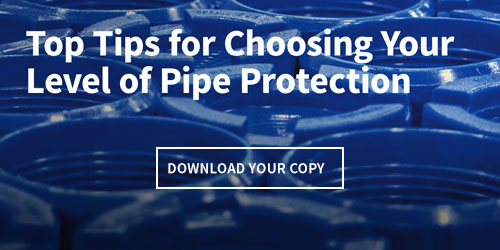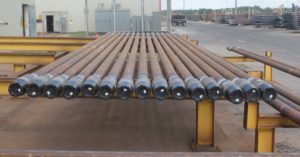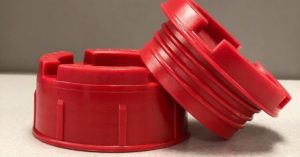Operating and maintaining a productive well requires a stringent inspection regimen. Regular inspections help identify any issues relating to the integrity of the downhole equipment and drill strings prior to failure. As (OCTG) Oil Country Tubular Goods remain a considerable investment for drilling operations. Therefore, maintaining their integrity during the handling, storage, installation, and production cycles is of vital importance. To help accomplish this goal, companies will always need reliable pipe protection tools and applications.
The American Petroleum Institute (API) publishes a set of recommended practices that determine which inspections operators should conduct on the different types of equipment. The specifications provide best practices in scenarios both prior to production (such as well completions) and after operations commence, in an attempt to prevent environmental damage and ensure the safety of staff at the site. A variety of inspection methods help operators identify failures early and help them to prevent catastrophic damage to operations. Unfortunately, these failures can inevitably lead to major production stoppages and losses of revenue.
API Standard OCTG Inspection Methods
Consequently, OCTG functions under various operational pressures. This is why operators must utilize an array of pipe inspection methods to ensure there are no equipment issues. If so, these methods also allow them to catch issues and resolve them proactively. For example, operators can carry out certain types of Non-Destructive Testing (NDT) in the field. Other tests, however, may require yard professionals to carry out line-flow inspections. Inspections focus on high-stress areas in the drill string, including slip and weld areas, threads, and anywhere the radius in the OCTG changes.
Inspections
To help drilling operators identify flaws, the inspections they conduct include:
-
- Standard visual inspection of OCTG
- Thread inspections according to API/RSC Technical Instructions
- Electromagnetic (EMI) and magnetic particle (MT) inspections
- Liquid Dye penetration testing and dimensional-wear inspections
- Ultrasonic inspections of rotary-shouldered connections (UT-RSC) or high-stress areas and tube upsets (UTEA)
The methods above help inspectors identify a variety of failures throughout the drill string, cladding, tubing, and other downhole equipment. Issues identified, such as a washout in a connection, cracks on threads and box connections, and over-torqued damage require immediate correction or replacement of the damaged section. Although there is no stipulated schedule for when to conduct inspections, operators have certain factors to consider. For example, signs of fatigue and load capacity are primary considerations for how frequent operators should carry out subsequent tests.
Post-Inspection Operations
During inspections, pipes and equipment will receive a class grade that determines whether operators can continue to use them safely. Any defects on the threads and interconnections require replacement, while decreases in diameter may still be usable in other applications. If producers don’t replace any of the damaged OCTG, it can lead to a well collapse that requires field operators to fish out whatever remains in the downhole, causing delays in production or, in a worst-case scenario, a complete loss of the well’s viability.
Applicable Standards for OCTG Inspections
In order to limit the impact of well operations on both the environment and the safety of personnel, the API and Bureau Veritas of North America (BVNA) developed a set of standards that apply to oil and gas operations. The BVNA’s fifth edition of the DS-1 set of standards is due for release in early 2020, but the current edition addresses all the requirements for drilling operations post-manufacturing, prior to installation, after use, and during well completions.
The volumes of DS-1 include:
-
-
- Inspections for newly manufactured tubular drilling equipment
- Methods for the prevention of equipment overload for risk-based design groups
- Reusable equipment for drilling and completions
- Assembly, inspection, and testing procedures for drilling and well-completion specialty tools
-
Additional inspection guidelines include the NS-2 Standard published by the Fearnley Proctor Group and the API’s Recommended Practice RP7G-2. These may vary in certain aspects, so for producers to keep operations running smoothly, they need to determine which applies to their specific set of conditions. As drilling operations become more complex, the NS-2 set of inspection specifications is becoming more widely used than the API RP7G-2 and DS-1 guidelines.
Methods for Protecting OCTG Onsite and During Storage
Although there’s little to prevent stress and torque fatigue from leading to equipment failures, regular inspections can prevent catastrophic damage to wells. Similarly, using pipe protection equipment on all OCTG during the transport, storage, handling, and installation will help protect investments and extend their usable lifecycles.
Thread Protectors and Sucker Rod Cap Pipe Protection
At MSI Pipe Protection Technologies, we help drilling operations maintain the integrity of all their essential OCTG. Our products include high-density polyethylene thread protectors and sucker rods caps or plugs. These will protect critical investments during handling and storage, preventing corrosion and shock damage to the connections in the overall drill string.
As the environmental conditions OCTG regularly face can lead to failures in the downhole, it’s vital to ensure each section remains protected during every stage of its lifecycle. MSI Pipe Protection Technologies provides a variety of solutions for drilling operators and OCTG manufacturers produced in accordance with the highest quality specifications.
For durable and reliable thread pipe protection, MSI provides:
-
-
- Drill pipe protectors (Guardian™)
- Magnum™ heavy-duty plastic thread protectors
- Perforating gun protectors (SealTite™)
- Tector™ and Tector Plus™ thread protectors
- Titan™ and Ultra™ tubing for premium connection protection
- MaxX™ protectors designed in accordance with API 5CT, Annex-I, 10th edition specifications
- Caps and plugs for sucker rod protection
-
Pipe Protection Storage and Handling Solutions
In order to keep all tubing, pipes, and other OCTG protected, MSI provides a variety of handling and storage equipment to maintain its integrity. Creating a safe distance of separation between tubes and pipes is vital to preventing corrosion and shock damage. It’s also important to provide reliable handling systems for when staff store, lift, and/or transport the equipment.
MSI provides storage and handling systems that include:
-
-
- Rhino™ tubular handling systems
- Pipe chocks and bumper rings (SpiraGuard™)
- Lifting bails and Roughneck™ Stabbing Guides
-
MSI Pipe Protection Technologies Improves OCTG Operational Integrity
Since 1980, MSI Pipe Protection Technologies has developed and designed innovative products that protect essential OCTG during every stage of the production lifecycles. MSI specializes in the design and manufacture of high-quality protective equipment for oil and gas operators according to ISO 9001 and 14001 certifications. With a range of solutions for standard thread connections and the ability to produce custom solutions for any special requirements, MSI offers the right pipe protection application to help ensure the integrity of all your OCTG, while also reducing the risk of catastrophic failures that lead to production losses.
To start providing pipe protection for your essential OCTG investments, speak to one of our service experts today. Or call us toll-free at 1-877-276-9208.






